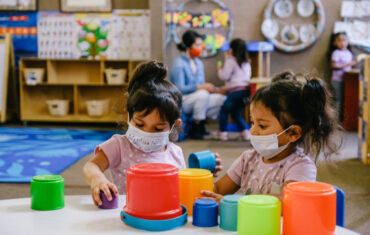Since so many people who have COVID-19 don’t have symptoms, wearing face cover reduces the chance of transmitting the virus through the spray of spit or respiratory droplets. To protect ourselves and others from COVID-19, the CDC now recommends cloth face cover be used when outside. Read on for answers to some frequently asked questions about fabric masks and children during the COVID-19 pandemic.
Should children wear fabric masks?
Children under the age of 2 years should not wear fabric masks.
When do children need to wear face masks?
This includes places where they may not be able to avoid staying 6 feet away from others. For example, if you have to take them to the doctor, pharmacy, or grocery store.
Places where children do NOT need to wear fabric masks:
- At home, assuming they have not been exposed to anyone with COVID-19.
- Outside, as long as they can stay at least 6 feet away from others and can avoid touching surfaces. For example, do not touch tables, water fountains, playground equipment or other things.
Cautions:
- Fabric masks are a possible choking or strangulation hazards to your child.
- Wearing the fabric masks causes your child to touch their face more frequently than not wearing it.
Staying home and physical distancing is still the best way to protect your family from COVID-19. Especially for younger children who may not understand why they can’t run up toward other people or touch things they shouldn’t. Children who are sick should not leave home.
What if my child is scared of wearing fabric masks?
- Look in the mirror with the face coverings on and talk about it.
- Put fabric masks on favorite stuffed animal.
- Decorate them so they’re more personalized and fun.
- Show your child pictures of other children wearing them.
- Draw one on their favorite book character.
- Practice wearing the fabric masks at home to help your child get used to it.
For children under 3, it’s best to answer their questions simply in language they understand. They can ask about why people are wearing fabric masks. Then, you can explain that sometimes people wear them when they are sick, and when they are all better, they stop wearing them.
For children over 3, try focusing on germs. Explain that germs are special to your own body. Some germs and good and some are bad. The bad ones can make you sick. Since we can’t always tell which are good or bad, the cloth face coverings help make sure you keep those germs away from your own body.
What about children with special health care needs?
Children who are considered high-risk or severely immunocompromised are encouraged to wear an N95 mask for protection.
Families of children at higher risk are encouraged to use a standard surgical face mask if they are sick to prevent the spread of illness to others.
How to wear a face mask?
Place the fabric masks securely over the nose and mouth and stretch it from ear to ear. Remember to wash your hands before and after you wear it and avoid touching it once it’s on your face. When back inside, avoid touching the front of the face covering by taking it off from behind. Wash cloth face coverings after each wearing.
What kind of cloth face masks is best?
Homemade or purchased cloth face covers are fine for most people to wear. For children, the right fit is important. Pleated fabric masks with elastic are likely to work best for kids. Try to find the right size for your child’s face and be sure to adjust it for a secure fit.






